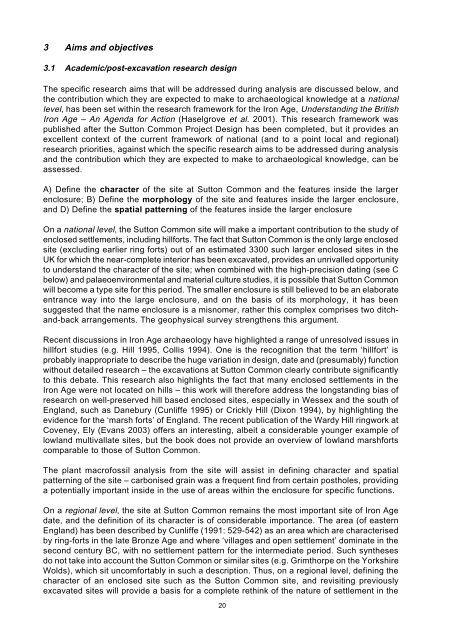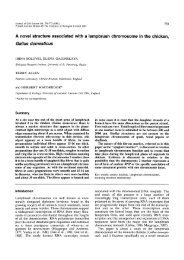Sutton Common Updated project design - University of Exeter
Sutton Common Updated project design - University of Exeter
Sutton Common Updated project design - University of Exeter
Create successful ePaper yourself
Turn your PDF publications into a flip-book with our unique Google optimized e-Paper software.
3 Aims and objectives<br />
3.1 Academic/post-excavation research <strong>design</strong><br />
The specific research aims that will be addressed during analysis are discussed below, and<br />
the contribution which they are expected to make to archaeological knowledge at a national<br />
level, has been set within the research framework for the Iron Age, Understanding the British<br />
Iron Age – An Agenda for Action (Haselgrove et al. 2001). This research framework was<br />
published after the <strong>Sutton</strong> <strong>Common</strong> Project Design has been completed, but it provides an<br />
excellent context <strong>of</strong> the current framework <strong>of</strong> national (and to a point local and regional)<br />
research priorities, against which the specific research aims to be addressed during analysis<br />
and the contribution which they are expected to make to archaeological knowledge, can be<br />
assessed.<br />
A) Define the character <strong>of</strong> the site at <strong>Sutton</strong> <strong>Common</strong> and the features inside the larger<br />
enclosure; B) Define the morphology <strong>of</strong> the site and features inside the larger enclosure,<br />
and D) Define the spatial patterning <strong>of</strong> the features inside the larger enclosure<br />
On a national level, the <strong>Sutton</strong> <strong>Common</strong> site will make a important contribution to the study <strong>of</strong><br />
enclosed settlements, including hillforts. The fact that <strong>Sutton</strong> <strong>Common</strong> is the only large enclosed<br />
site (excluding earlier ring forts) out <strong>of</strong> an estimated 3300 such larger enclosed sites in the<br />
UK for which the near-complete interior has been excavated, provides an unrivalled opportunity<br />
to understand the character <strong>of</strong> the site; when combined with the high-precision dating (see C<br />
below) and palaeoenvironmental and material culture studies, it is possible that <strong>Sutton</strong> <strong>Common</strong><br />
will become a type site for this period. The smaller enclosure is still believed to be an elaborate<br />
entrance way into the large enclosure, and on the basis <strong>of</strong> its morphology, it has been<br />
suggested that the name enclosure is a misnomer, rather this complex comprises two ditchand-back<br />
arrangements. The geophysical survey strengthens this argument.<br />
Recent discussions in Iron Age archaeology have highlighted a range <strong>of</strong> unresolved issues in<br />
hillfort studies (e.g. Hill 1995, Collis 1994). One is the recognition that the term ‘hillfort’ is<br />
probably inappropriate to describe the huge variation in <strong>design</strong>, date and (presumably) function<br />
without detailed research – the excavations at <strong>Sutton</strong> <strong>Common</strong> clearly contribute significantly<br />
to this debate. This research also highlights the fact that many enclosed settlements in the<br />
Iron Age were not located on hills – this work will therefore address the longstanding bias <strong>of</strong><br />
research on well-preserved hill based enclosed sites, especially in Wessex and the south <strong>of</strong><br />
England, such as Danebury (Cunliffe 1995) or Crickly Hill (Dixon 1994), by highlighting the<br />
evidence for the ‘marsh forts’ <strong>of</strong> England. The recent publication <strong>of</strong> the Wardy Hill ringwork at<br />
Coveney, Ely (Evans 2003) <strong>of</strong>fers an interesting, albeit a considerable younger example <strong>of</strong><br />
lowland multivallate sites, but the book does not provide an overview <strong>of</strong> lowland marshforts<br />
comparable to those <strong>of</strong> <strong>Sutton</strong> <strong>Common</strong>.<br />
The plant macr<strong>of</strong>ossil analysis from the site will assist in defining character and spatial<br />
patterning <strong>of</strong> the site – carbonised grain was a frequent find from certain postholes, providing<br />
a potentially important inside in the use <strong>of</strong> areas within the enclosure for specific functions.<br />
On a regional level, the site at <strong>Sutton</strong> <strong>Common</strong> remains the most important site <strong>of</strong> Iron Age<br />
date, and the definition <strong>of</strong> its character is <strong>of</strong> considerable importance. The area (<strong>of</strong> eastern<br />
England) has been described by Cunliffe (1991: 529-542) as an area which are characterised<br />
by ring-forts in the late Bronze Age and where ‘villages and open settlement’ dominate in the<br />
second century BC, with no settlement pattern for the intermediate period. Such syntheses<br />
do not take into account the <strong>Sutton</strong> <strong>Common</strong> or similar sites (e.g. Grimthorpe on the Yorkshire<br />
Wolds), which sit uncomfortably in such a description. Thus, on a regional level, defining the<br />
character <strong>of</strong> an enclosed site such as the <strong>Sutton</strong> <strong>Common</strong> site, and revisiting previously<br />
excavated sites will provide a basis for a complete rethink <strong>of</strong> the nature <strong>of</strong> settlement in the<br />
20
















